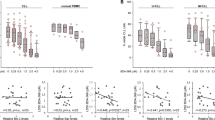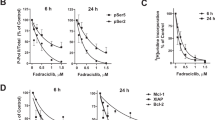Abstract
Cytotoxic drugs used in chemotherapy of leukemias and solid tumors cause apoptosis in target cells1,2. In lymphoid cells the CD95 (APO–1/Fas)/CD95 ligand (CD95–L) system is a key regulator of apoptosis3–6. Here we describe that doxorbicin induces apoptosis via the CD95/CD95–L system in human leukemia T–cell lines. Doxorubicin–induced apoptosis was completely blocked by inhibition of gene expression and protein synthesis. Also, doxorbicin strongly stimulated CD95–L messenger RNA expression in vitro at concentrations relevant for therapy in vivo. CEM and Jurkat cells resistant to CD95–mediated apoptosis were also resistant to doxorbicin–induced apoptosis. Furthermore, doxorbicin–induced apoptosis was inhibited by blocking F(ab′)2 anti–APO–1 (anti–CD95) antibody fragments. Expression of CD95–L mRNA and protein in vitro was also stimulated by other cytotoxic drugs such as methotrexate. The finding that apoptosis caused by anticancer drugs may be mediated via the CD95 system provides a new molecular insight into resistance and sensitivity toward chemotherapy in malignancies.
This is a preview of subscription content, access via your institution
Access options
Subscribe to this journal
Receive 12 print issues and online access
$209.00 per year
only $17.42 per issue
Buy this article
- Purchase on Springer Link
- Instant access to full article PDF
Prices may be subject to local taxes which are calculated during checkout
Similar content being viewed by others
References
Barry, M.A., Behnke, C.A. & Eastman, A. Activation of programmed cell death (apoptosis) by cisplatin, other anticancer drugs, toxins and hyperthermia. Biochem. Pharmacol. 40, 2353–2362 (1990).
Hickman, J.A. et al. Apoptosis and cancer chemotherapy. Philos. Trans. R. Soc. Land. B. Biol. Sci. 345 (1313) 319–325 (1994).
Trauth, B.C. et al. Monoclonal antibody-mediated tumor regression by induction of apoptosis. Science 245, 301–305 (1989).
Debatin, K.-M., Goldman, C.K., Bamford, R., Waldmann, T.A. & Krammer, P.M. Monoclonal antibody-mediated apoptosis in adult T cell leukemia. Lancet 335, 497–500 (1990).
Debatin, K.-M., Goldman, C.K., Waldmann, T.A. & Krammer, P.H. APO-1 induced apoptosis of leukemia cells from patients with adult T cell leukemia. Blood 81, 2972–2977 (1993).
Krammer, P.H. et al. The role of APO-1-mediated apoptosis in the immune system. Immunol. Rev. 142, 175–191 (1994).
Dhein, J., Walczak, H., Bäumler, C., Debatin, K.M. & Krammer, P.H. Autocrine T cell suicide mediated by APO-1 (Fas/CD95). Nature 373, 438–441 (1995).
Oehm, A. et al. Purification and molecular cloning of the APO-1 surface antigen, a member of the TNF/NGF receptor superfamily. J. Biol. Chem. 267, 10709–10715 (1992).
Itoh, N. et al. The polypeptide encoded by the cDNA for human cell surface antigen Fas can mediate apoptosis. Cell 66, 233–243 (1991).
Klas, C., Debatin, K.M., Jonker, R.R. & Krammer, P.H. Activation interferes with the apoptotic pathway in mature human T cells. Int. Immunol. 5, 625–630 (1993).
Kischkel, F.C. et al. Cytotoxicity-dependent APO-1 (Fas/CD95)-associated proteins (CAP) form a death-inducing signalling complex (DISC) with the receptor. EMBO J. (in the press).
Suda, T., Takahashi, S., Golstein, P. & Nagata, S. Molecular cloning and expression of the Fas ligand, a novel member of the tumor necrosis factor family. Cell 75, 1169–1178 (1993).
Tanaka, M., Suda, T., Takahashi, T. & Nagata, S. Expression of the functional soluble form of human Fas ligand in activated lymphocytes. EMBO J. 14, 1129–1135 (1995).
Mariani, S.M., Matiba, B., Baumler, C. & Krammer, P.H. Regulation of cell surface APO-1/Fas (CD95) ligand expression by metalloproteases. Eur. J. Immunol. 25, 2303–2307 (1995).
Muller, C. et al. Cellular pharmacokinetics of doxorubicin in patients with chronic lymphocytic leukemia: Comparison of bolus administration and continuous infusion. Cancer Chemother. Pharmacol. 32, 379–384 (1993).
Cusack, B.J., Young, S.P., Driskell, J. & Olson, R.D. Doxorubicin and doxorubicinol pharmacokinetics and tissue concentrations following bolus injection and continuous infusion of doxorubicin in the rabbit. Cancer. Chemother. Pharmacol. 32, 53–58 (1993).
Skladanowski, A. & Konopa, J. Adriamycin and daunomycin induce programmed cell death (apoptosis) in tumor cells. Biochem. Pharmacol. 46, 375–382 (1993).
Thakkar, N.S. & Potten, C.S. Abrogation of adriamycin toxicity in vivo by cy-cloheximide. Biochem. Pharmacol. 43, 1683–1691 (1992).
Debatin, K.-M. & Krammer, P.H. Resistance to APO-1 (CD95) induced apoptosis in T-ALL is determined by a BCL-2 independent antiapoptotic program. Leukemia 9 (5), 815–820 (1995).
Bose, R. et al. Ceramide synthase mediates daunorubicin-induced apoptosis: An alternative mechanism for generating death signal. Cell 82, 405–414 (1995).
Cifone, M.G. et al. Apoptotic signaling through CD95 (Fas/APO-1) activates an acidic sphingomyelinase. Exp. Med. 177, 1547–1552 (1994)
Nicholson, D.W. et al. Identification and inhibition of ICE/CED-3 protease necessary for mammalian apoptosis. Nature 376, 37–43 (1995).
Nicoletti, I., Migliorati, G., Pagliacci, M.C., Grignani, F. & Riccardi, C. A rapid and simple method for measuring thymocyte apoptosis by propidium iodide staining and flow cytometry. J. Immun. Methods 139, 271–279 (1991).
Carbonari, M. et al. Detection and characterization of apoptotic peripheral blood lymphocytes in human immunodeficiency virus-infection and cancer chemotherapy by a novel flow immunocytometric method. Blood 83, 1268–1277 (1994).
Herr, I. et al. Monitoring of CD95 (APO-1/FAS) ligand expression in human T cells by quantitative RT-PCR. Cell Death Diff. (in the press).
Author information
Authors and Affiliations
Rights and permissions
About this article
Cite this article
Friesen, C., Herr, I., Krammer, P. et al. Involvement of the CD95 (APO–1/Fas) receptor/ligand system in drug–induced apoptosis in leukemia cells. Nat Med 2, 574–577 (1996). https://doi.org/10.1038/nm0596-574
Received:
Accepted:
Issue Date:
DOI: https://doi.org/10.1038/nm0596-574
This article is cited by
-
CD95/Fas ligand mRNA is toxic to cells through more than one mechanism
Molecular Biomedicine (2023)
-
MPEG-phenylboronic acid modified doxorubicin as the efficient pathological pH-responsive nanoplatform for potential anti-cancer delivery
Macromolecular Research (2023)
-
Therapeutic approaches targeting CD95L/CD95 signaling in cancer and autoimmune diseases
Cell Death & Disease (2022)
-
D,L-Methadone enhances the cytotoxic activity of standard chemotherapeutic agents on pediatric rhabdomyosarcoma
Journal of Cancer Research and Clinical Oncology (2022)
-
Novel therapy for pediatric and adolescent kidney cancer
Cancer and Metastasis Reviews (2019)



